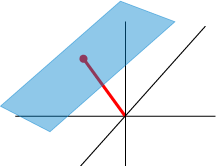Section3.3Week 7 (Jul 9-13)
¶This week, we'll finish up the key idea of Chapter 3: how a basis can be used both to describe the (infinitely many) elements in a vector space using a much smaller set, and to define a system of coordinates on that space. We'll extend that knowledge to how bases determine subspaces -- that is, smaller vector spaces residing within bigger ones. Subspaces will play an important role in the concluding chapter of our course, and writing down a basis is among the best ways of understanding and communicating about subspaces.
We'll be taking the sections in Chapter 3 a little out of order, coming back for 3.4 Determinants when the final chapter begins.
To do this week:
By Friday 7/13:
- Submit Quiz 6R via Blackboard.
By Saturday 7/14:
- Read and annotate 3.2: Bases and Coordinate Systems https://via.hypothes.is/http://merganser.math.gvsu.edu/david/linear.algebra/ula/ula/sec-bases.html
- Read and annotate 3.5: Subspaces of \(\mathbb{R}^p\) https://via.hypothes.is/http://merganser.math.gvsu.edu/david/linear.algebra/ula/ula/sec-subspaces.html
- Watch here for Lectures 6 and 7.
